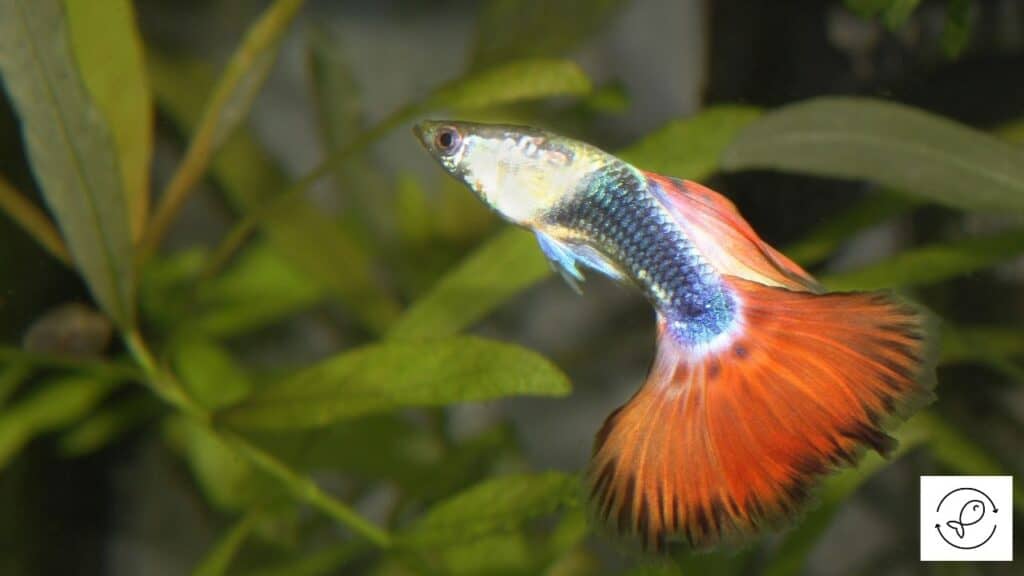Guppies are one of the most popular fish in the aquarium hobby.
They’re an excellent choice for beginners who want to start their own fish tank.
Guppies need little maintenance, are docile, easy to care for, and hardy, making them good introductory fish for beginner aquarists.
Let’s learn more about these beautiful fish in more detail.
Guppy Species Overview
Guppy fish (Poecilia reticulata) is also known as rainbow fish and millionfish. It’s a member of the Poeciliidae family.
Guppies originated from northeast South America. However, they’re most prevalent in Guyana and Brazil.
Due to their vast distribution, guppies have been introduced to many environments and are found worldwide, except Antarctica.
Guppies prefer freshwater habitats. However, they can survive in a brackish ecosystem.
Due to their small size, guppies avoid fast-moving or deep water bodies and are usually found in ponds, lakes, streams, and other small pools of water.
Guppies are also considered a cheap and reliable option to reduce the mosquito population due to their propensity to consume mosquito larvae.
Appearance
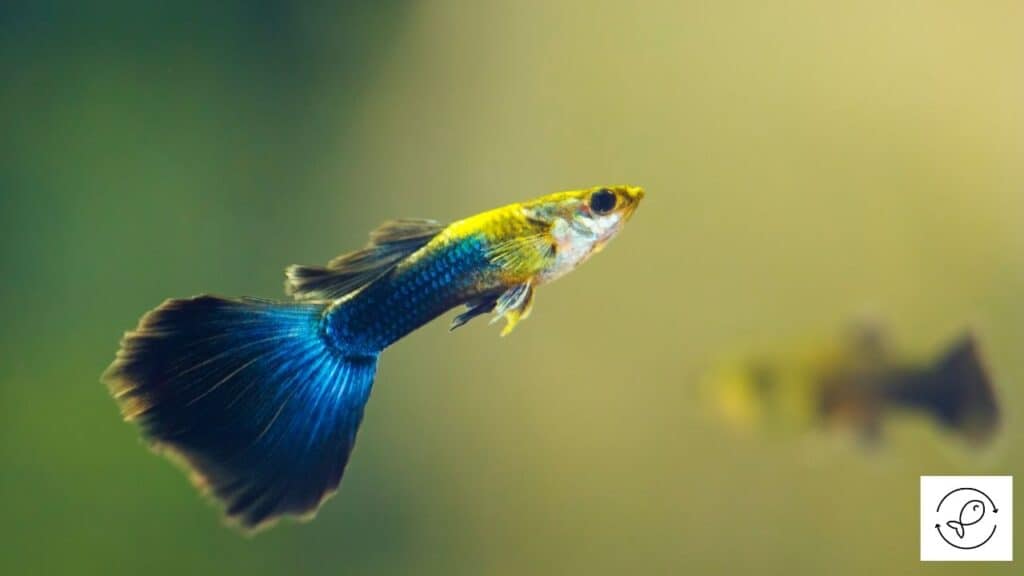
Guppies are popular for their stunning coloration and beautiful markings, including stripes, spots, bars, or even a combination of all three.
Depending on the species, guppies can be in red, blue, yellow, green, black, white, or orange color.
Also, male guppies are brighter than females and have longer dorsal and caudal fins.
Guppies have a fan-shaped fin that’s comparatively larger than the rest of their body.
Depending on the variety, some guppies have rounded, short tails, some have V-shaped tails, and others have an elongated tail that’s half the length of their body.
Besides, both male and female guppies have flowing fins.
Names of Species
There are over 300 recognized species of guppies. But only a few are widely seen in the aquarium trade.
Guppies are generally classified by their characteristics as they’re found in varied colors, patterns, tail shapes, and eye colors.
It isn’t easy to list all the species due to their huge count.
Nonetheless, we have listed the most popular guppy species below.
| By Color | White guppy, Blue guppy, Neon Blue guppy, Japanese Blue guppy, Black guppy, Red guppy, Purple guppy, Albino guppy, Yellow guppy, Golden guppy, Green guppy, Bronze guppy, Half-Black Red guppy, Half-Black Blue guppy, Half-Black Green guppy, Half-Black Pastel guppy, Bi-Colored guppy, Multi Colored guppy, Solid Colored guppy, Koi guppy, Metal guppy, Dragon guppy, Panda guppy |
| By Eye Color | Real Red Eye Albino guppy, Real Red Eye guppy |
| By Tail Shape | Triangle-Tail, Speartail, Halfmoon tail, Roundtail, Top Swordtail, Double Swordtail, Bottom Swordtail, Cofertail, Fantail, Lyretail, Pintail |
| By Pectoral Fins | Dumbo Ear guppy |
| By Body Pattern | Cobra guppies, Snakeskin guppies, Tuxedo guppies |
| Other Types | Fancy Guppies, Mutt Guppies, Endler Guppy, Swamp Guppies |
Lifespan
The life of guppies varies around 2 to 5 years. It also depends on whether they live in the wild or captivity.
Guppies have an average lifespan of around two years in the wild.
Many factors affect their lifespan in the wild, like predation and extreme weather conditions like floods, freezing weather, etc.
In contrast, guppies can even live up to 5 years in captivity, provided the conditions are favorable.
Balanced nutritious food, lack of stress, favorable water parameters, and good genetics can increase guppies’ lifespan.
Average Size
Guppies are tiny fish. The average size of guppies is about 2 inches long. Female guppies are larger than their male counterparts.
The average size of male guppies is 1.5 cm to 5 cm (0.6 in to 1.97 in) long, whereas females are 3 cm to 6 cm (1.2 in to 2.36 in) long.
Guppy Tank Setup
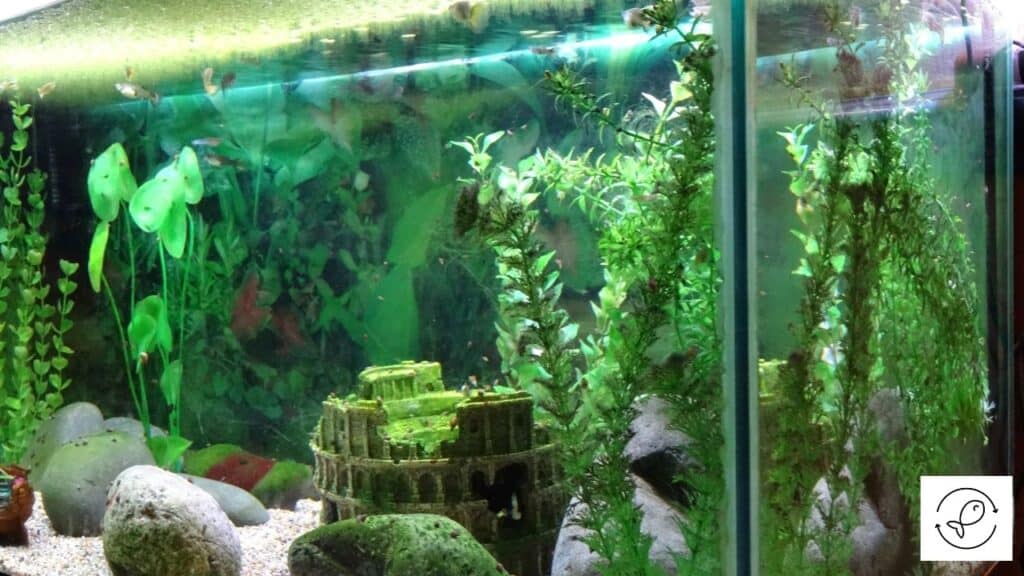
When you think of setting up an aquarium, the first thing that comes to mind is how big the tank should be and the equipment required for the same.
So let’s understand how to set up a guppy tank in detail.
Tank Size
The size of a guppy tank largely depends on the number of guppies you wish to keep.
A minimum of 10-gallon tank is recommended for a small group of guppies.
Although guppies are tiny, they’re active and need ample space to swim in the tank.
Hence, a larger tank is recommended as it ensures a comfortable amount of space for all the guppies.
Besides, a large tank can also easily accommodate the aquarium equipment and live plants.
It’s even more helpful if you plan to breed guppies.
Tank Equipment And Decorations
Guppies aren’t high-maintenance fish. Unlike other tropical fish, guppies aren’t picky about the decorative items in their tank.
However, while setting up a tank, it’s best to replicate their natural environment as it gives them a sense of security.
Also, installing certain equipment in the tank ensures that guppies live a healthy life.
Given below are items required in a guppy tank:
- Substrate,
- Filter,
- Heater,
- Live Plants like Java Moss, Java Fern, etc.
- Aquarium Lights,
- Decorations like driftwood, artificial rocks, caves, plastic decorations, etc.
You may also need other things depending on how you set up the aquarium.
Guppy Care
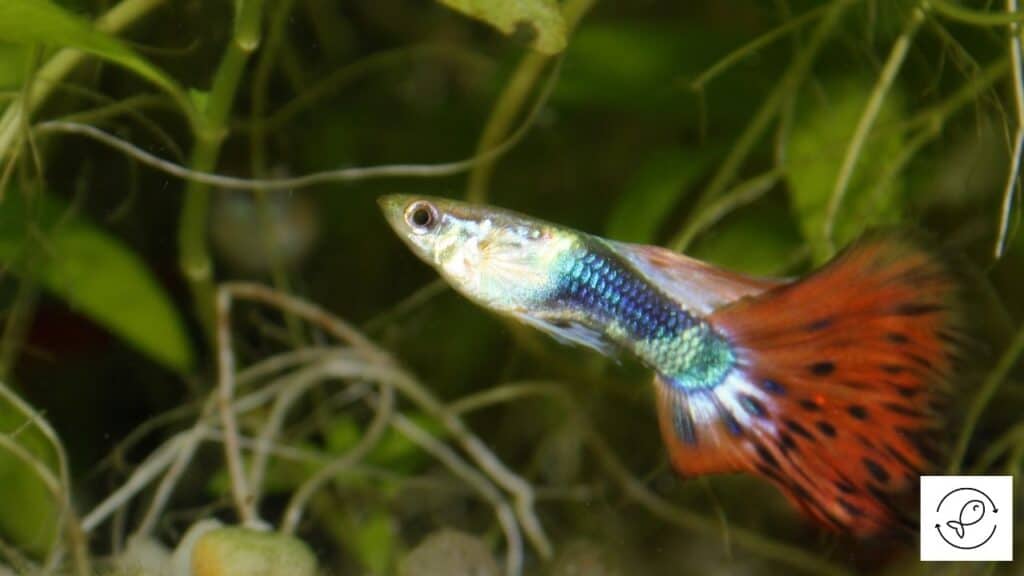
Guppies, although hardy fish, need adequate care for healthy development.
They require proper nutrition, clean water, and suitable water parameters.
Let’s see how you can take proper care of your guppies.
Diet
Guppies are non-fussy eaters. They eat both plant and animal matter that fits into their mouths in the wild.
Wild guppies feed on algae, plant remains, vegetable matter, tiny crustaceans, diatoms, aquatic insect larvae, and other sources.
You can feed guppies a balanced and nutritious diet consisting of high-quality flakes and pellets in captivity.
You can even feed bloodworms and brine shrimp that are high in protein and fat as an occasional treat to guppies.
Among homemade food, you can feed finely chopped veggies like mustard, greens, lettuce, peas, and zucchini.
You can also feed bite-sized fruits like bananas and grapes occasionally.
Hard-boiled egg yolk in small quantities is another good option for guppies.
Water Parameters
The best thing for any fish is to replicate their natural environment.
Guppies being tropical fish, prefer warm water with an overall neutral pH balance.
Water temperature, pH level, and water hardness are critical parameters for guppies.
The ideal water parameters to keep guppies healthy are:
| Water Temperature | 72°F to 82°F (22°C to 28°C) |
| Water pH | 6.8 to 7.8 |
| Water Hardness (dGH) | 8 to 12 |
Tank Maintenance
Maintaining the guppy tank is of utmost importance. This will ensure that your guppies stay healthy throughout their lifetime.
Depending upon how many guppies you have and how messy the tank has become, it needs to be cleaned.
You can clean the tank once every fortnight.
While cleaning, you need to replace about 25% of the water with fresh, dechlorinated water.
You should also clean the gravel regularly with a siphon hose so that there’s no accumulation of waste products, leftover food, and algae at the bottom of the tank.
The inner portion of the glass also needs to be cleaned regularly, along with the aquarium decorations placed inside the tank.
Common Diseases
Guppies are resilient tiny creatures that can withstand harsh conditions.
Having said that, they’re not immune to diseases.
Like other captive tropical fish, guppies are susceptible to fungal, bacterial, and parasitic infestations.
Moreover, the closed environment of a home aquarium spreads diseases quickly.
Some of the major guppy diseases are:
- Fin Rot,
- Ich,
- Swim Bladder Disease,
- Dropsy,
- Constipation,
- Protozoan, and
- Bent Spine Disease.
Guppy Behavior And Temperament
Guppies are docile fish. They’re very friendly toward other community fish and get along well with like-minded species.
However, guppies can become aggressive when certain conditions aren’t met.
They can become aggressive in case of overcrowding, food scarcity, unfavorable water parameters, stress, less or absence of female guppies for mating, and if kept in small groups.
Guppy Tankmates
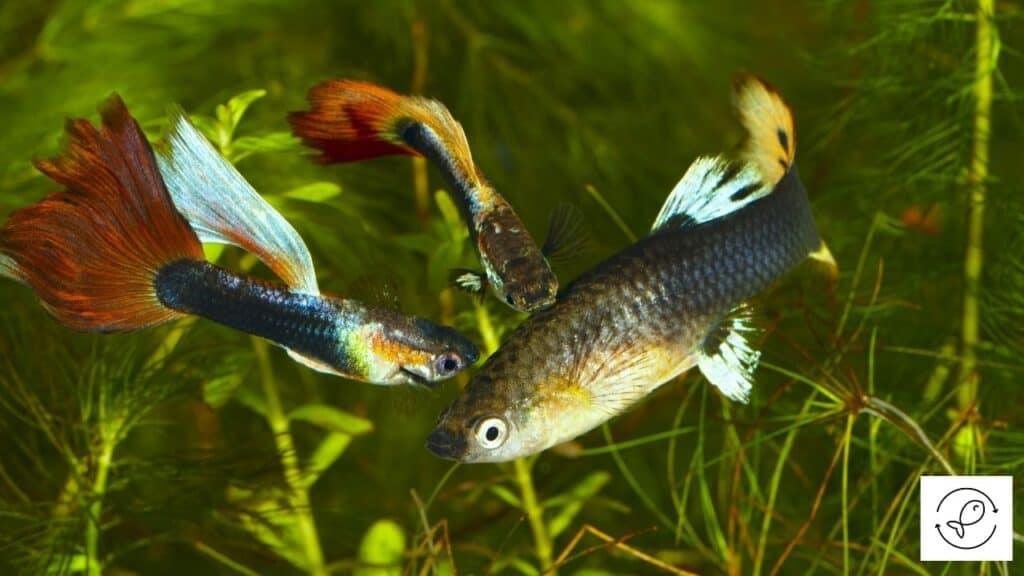
The best guppy tankmates are their own kind. Guppies do well when kept in a group of at least six or more.
When kept in a small group or alone, guppies can feel vulnerable and spend most of their time hiding.
Guppies being peaceful can be housed with non-aggressive species. They also need to be kept with similar-sized fish.
Some of the popular compatible tankmates for guppies are:
- Platies,
- Mollies,
- Cory Catfish,
- Neon Tetras,
- Cardinal Tetras,
- Kuhli Loach,
- Honey Gouramis,
- Swordtails,
- Bristlenose Plecos,
- Otocinclus Catfish,
- Shrimp such as Amano shrimp, crystal red shrimp, red cherry shrimp, etc.,
- Nerite Snails, and
- African Dwarf Frog.
Although guppies are compatible with most fish, you should avoid some fish species.
You must not keep any sizeable predatory, aggressive, or fin-nipping fish with guppies.
Fish species that you can’t keep with guppies include:
- Angelfish,
- Endler’s Livebearers, and
- Cichlids.
Guppy Breeding
Guppies are known for their breeding capabilities.
They breed profusely when both genders are present in the tank, and the tank conditions are ideal.
Guppies are livebearers, meaning they give live birth to numerous fry.
The male guppies fertilize and transfer their sperm into the female guppies’ reproductive tract during the mating process.
The offspring then develops in the female guppies’ bodies until they hatch and fry are born.
The gestation period of guppies varies between 21 to 30 days, with the average being 22 to 26 days.
Since guppies can store sperms in their body for up to a year with a single mating encounter, they can reproduce every month without any male guppy in the vicinity.
Guppies also breed a lot as they mature and can begin reproducing at an early age of 3 months.
Female guppies deliver around 2 to 200 fry at a time. They take around 2 to 6 hours to deliver all the fry.
The fry are born one at a time and in quick succession with pauses between groups of fry.
However, if the pregnant female guppy is stressed, she may produce less fry, maybe only 3 to 5.
Also, under such circumstances, the survival chances of the fry are minimum.
Fry delivered under stressful conditions aren’t viable and can perish immediately after birth.
Frequently Asked Questions
Where Do Guppies Come From?
Guppies come from the slow-moving streams, lakes, rivers, and canals. They originated in northeast South America during the 18th century. However, guppies are now found on all continents except Antarctica. They come from the Poeciliidae family and owe their name to Robert John Lechmere Guppy.
How Big Do Guppies Get?
Male guppies can grow up to 1.5 inches (3.8 cm) in size, while female guppies can grow up to 2 inches (5 cm). Under suitable living conditions, guppies with good genetic backgrounds can grow to full size in around 6 months. A nutritious diet and proper care are the keys to guppies’ optimal growth.
Do Guppies Lay Eggs Or Give Live Birth?
Guppies don’t lay eggs; they give live birth because they are livebearers. Female guppies store the eggs inside their body during pregnancy. Once the eggs hatch, they release multiple guppy fry from their body. The gestation period of guppies varies from 21 to 30 days, depending on various factors.
How Many Babies Do Guppies Have?
Guppies have 2 to 200 babies at a time. The guppy babies are born live one after the other in small batches over 6 hours. Guppies give birth every 30 days under optimal conditions. Since their gestation period is less than a month, they give birth to around 2000 babies in their lifetime.
Why Do Guppies Breed So Much?
Guppies breed a lot as they mature and begin reproducing from the age of three months. They mate all the time, and female guppies have a short gestation period. Moreover, a single mating cycle is enough for female guppies to have several batches of offspring, with each batch containing 30 to 50 fry.
Are Guppies Hardy?
Guppies are hardy. Their ability to adapt to a challenging environment makes them one of the hardiest aquarium fish. Although guppies are hardy, they are not invulnerable. They are usually prone to fungal infections due to their long tails. Guppies can fall sick if kept in unsuitable habitat.
Do Guppies Need A Heater?
Guppies need a heater. Their body needs to stay warm at all times for them to live a long and stable life. A heater ensures that the aquarium’s water temperature is always ideal for the guppies. If guppies are exposed to cold water, they will fall sick and may even die because of it.
Can Guppies Live Together?
Guppies can live together. They are schooling fish and so like to be kept in groups. Guppies are peaceful fish. However, they get aggressive and start fighting with each other if the male-to-female ratio is incorrect, there is overcrowding in the tank, or if they don’t get sufficient food.
Can Guppies Live With Tetras?
Guppies and tetras comfortably co-exist in the same tank. The habitat and feeding needs of both fish are similar. The tank setup is also more or less similar for guppies and tetras. Additionally, guppies and tetras are peaceful fish and get along with each other.
Can Guppies Live With Angelfish?
Guppies cannot live with angelfish. Guppies are peaceful community fish, while angelfish are aggressive. Fully-grown angelfish are bigger than guppies and will most likely chase and attack them. Since angelfish display predatorial instincts, guppies will not be safe in their presence.
Can Guppies Live With Platies?
Guppies can live with platies in the same aquarium as both are peaceful fish. They also have similar requirements for tank size, water conditions, water temperature, pH levels, and have more or less the same feeding needs. Both of these species are livebearers too.
Can Guppies Live With Mollies?
Guppies and mollies can live together. Both species are peaceful and have similar environmental and feeding needs. Guppies and mollies tend to be friendly with each other most of the time. Since they rarely attack each other, these two types of fish can comfortably co-exist in the same tank.
Do Guppies Bite?
Guppies bite each other or their tank mates under stressful conditions. They become aggressive and resort to biting for defending their territory. Guppies also bite due to lack of space, food scarcity, stress, poor water quality, unfavorable water parameters, and the absence of females to mate.
What Do Baby Guppies Eat?
Baby guppies eat a protein-rich diet for their healthy development. Live food items such as bloodworms, daphnia, tubifex, and baby brine shrimp are excellent sources of proteins and nutrients for baby guppies. Apart from live food, they like to eat high-quality flakes, freeze-dried and frozen food.
Can Guppies Eat Bread?
Guppies can eat bread. However, it is not recommended to feed bread to guppies. It has yeast that causes digestion issues in fish. Bread also doesn’t have the nutrients or minerals guppies need. It contains sugar, corn syrup, preservatives, and flavoring agents that are unhealthy for guppies.
Can Guppies Eat Betta Food?
Guppies can eat betta food since they are omnivores. However, it isn’t a wholesome food for guppies. Betta food is mostly meat-based proteins, but guppies also need plant-based nutrients. So, guppies need vegetable pellets or other plant-based food in addition to the meat-based betta food.
Do Guppies Eat Algae?
Guppies do eat algae. Eating algae is not harmful to guppies, but it does not provide any nutritional value to them either. Excess growth of algae in the aquarium is dangerous as it depletes the nutrients and oxygen levels from the water, which are essential for the development of guppies.
What Do Fancy Guppies Eat?
Fancy guppies eat both animal and plant-based food items. A rich and varied diet of both store-bought and fresh foods will help them thrive. You can feed fancy guppies commercial flake food and pellets regularly and occasionally treat them to live or frozen food like bloodworms and brine shrimp.
Do Guppies Sleep?
Guppies do sleep. While sleeping, they float at the top of the tank, on the gravel at the tank’s bottom, or near the plant decoration in the tank. Since guppies do not have eyelids, they sleep with their eyes open. You will usually find guppies sleeping at night when the lights are off.
Do Guppies Need Light?
Guppies do need light to grow and live a healthy life. The amount of light that they need in a fish tank is approximately the same as they would get in their natural habitat. This means that the light needs to be kept on for about 8 to 10 hours a day and should be switched off at night.
Why Are Guppies So Colorful?
Guppies are colorful because of their reproduction preferences. Male guppies are more colorful than females. Their colors attract female guppies because they associate the vibrant colors of the males with fertility and health. However, wild guppies are drabber to protect themselves from predators.
Do Guppies Change Gender?
There are no scientific studies that suggest guppies change their gender. However, gender change is a common phenomenon in marine fish species. So, like many livebearer fish that spontaneously change gender, it’s theoretically possible for guppies to change gender if the circumstances demand it.
Can Guppies Eat Ants?
While guppies can eat ants, it is not recommended to feed ants to guppies. Ants are high in formic acid and release various chemicals when threatened. These chemicals cause side-effects in guppies. While the chemicals may not harm large fish, the same is not true for smaller fish like guppies.
Do Guppies Contain Thiaminase?
Guppies don’t contain thiaminase. There are no studies that indicate the presence of thiaminase in guppies. That is why guppies are generally considered to be safe from a thiaminase perspective. Hence, expert aquarists recommend the use of guppies as feeder fish instead of goldfish and minnows.
Why Do Guppies Die?
Given below are the main reasons that result in the untimely death of guppies:
- Poor water quality,
- Stress,
- Uncycled tank,
- Overfeeding,
- Overcrowding,
- Illness,
- Unsuitable water temperature,
- Incompatible tank mates,
- Irregular tank maintenance,
- Unsuitable living conditions,
- Poor gene inheritance, and
- Increased ammonia levels.
Do Guppies Die After Giving Birth?
Guppies do die after giving birth. This is mainly due to stress. Apart from stress, there are other factors too that lead to the death of your female guppies. Labor complications, inadequate water parameters, any prior sickness, or illness to your female guppies lead to their death.
How To Stop Guppies From Dying?
You can stop your guppies from dying by:
- Maintaining water quality,
- Feeding nutritious diet,
- Avoiding overfeeding,
- Avoiding overcrowding,
- Treating diseases,
- Maintaining the tank,
- Avoiding stress,
- Avoiding sudden temperature change,
- Cycling the tank, and
- Keeping compatible tank mates.

